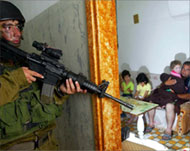Palestinian resistance leaders killed
Seven Palestinian resistance fighters, among them three senior leaders, have been killed in the West Bank city of Nablus, witnesses said.

The Israeli occupation force had no immediate comment. Palestinian medics, who checked the bodies, said on Saturday that they were riddled with bullets.
Aljazeera’s correspondent in Ram Allah said six of them were killed when Israeli forces encircled a group of al-Aqsa Martyrs’ Brigade fighters in a tunnel. Another brigade fighter was killed elsewhere in the city.
Among those killed was Nayif Abu Sharkh, appointed two months ago as the West Bank leader of the brigades. The group is a part of Palestinian President Yasir Arafat’s Fatah faction.
The local leader of the military wing of Hamas in Nablus and the top commander of Islamic Jihad in the West Bank city of Jenin, who has been in Nablus for the past two years, were also among the dead.
Searches
Earlier on Saturday, the Israeli forces carried out house-to-house searches in the old quarter for the third consecutive day.
The troops also intercepted the funeral procession of two Palestinian youths shot dead by occupation soldiers the previous day, and took away some men from among the group.
The searches and detentions were part of a larger Israeli army operation in the vicinity of the cemetery, ostensibly to apprehend Palestinian activists on Israel‘s wanted list.
Ihab Mahir Salim, 19, was killed and his father and two brothers wounded when, according to eye witnesses, Israeli troops fired into their home on Friday evening. Informed Palestinians said Salim was unarmed and did not belong to any political group.
Also on Friday, Palestinian Muhammad al-Faqha, 18, was shot dead by an Israeli sniper apparently for violating curfew orders.
In other parts of Nablus, Israeli soldiers rounded up hundreds of male residents and confined them in schoolyards for hours in scorching heat.
In dire straits
Since Thursday, the occupation forces have blocked off all roads and junctions leading to Nablus‘s old town with barbed wire and rocks, and detonated several old buildings.
As a result of the blockade, humanitarian conditions in the town have sharply deteriorated. There is a shortage of food.
 |
|
Israeli soldiers take up position |
Additionally, two neighbourhoods – Raa al-Ain and Faisal Street – are under curfew.
The Red Cross and other relief agencies have tried to deliver food and milk but their attempts have been unsuccessful.
The Aljazeera team was denied permission to enter the town on Friday and Saturday.
Israel justifies its regular incursions into Palestinian population centres as necessary for preventing militant attacks on Israeli soldiers and settlers.
Palestinians say the raids often take the form of violent rampages in which civilians are killed, homes are destroyed and public infrastructure and private property vandalised.
Tulkarim violence
In a separate development, the Israeli army used tear gas, rubber bullets and truncheons to disperse some 2000 Palestinian, Israeli and international demonstrators protesting against the building of the annexation wall west of Tulkarim, in northern West Bank.
Medical sources said several protesters were injured in scuffles with soldiers while others complained of symptoms associated with tear-gas inhalation.
Earlier, Palestinian medical sources had accused Israel of using a “sinister variety” of crowd-control gases which had serious effects on victims – such as recurrent convulsions, blurred vision, widening of the eye pupil and stomach pain.
|
“The occupation army doesn’t hesitate to open fire on civilians. They think that we are a hostile population because we demand an end to their occupation”
Anat Aalatira,
Coordinator-Nablus,
Health Emergency Services
|
Awni Khatib, professor of chemistry at Hebron University, said the new symptoms – particularly the violent convulsions experienced by some Palestinian protesters outside the village of Sawiya, southwest of Nablus – suggested that the Israeli army may be using a new class of chemicals that lie somewhere between normal tear gas and chemical weapons.
On Friday a special United Nations investigating team criticised Israel for excessive use of force and destruction of homes in the occupied Palestinian territories.
In a joint statement, the team urged the Security Council to deploy an international protection force to stop Israeli abuses.